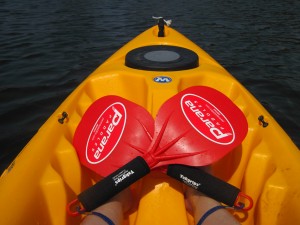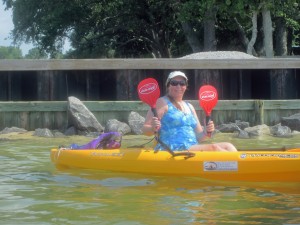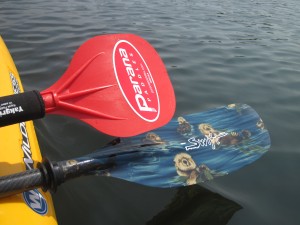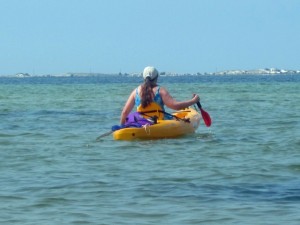After several weekends of uncooperative weather I finally caught a break and was able to get my kayak out on the water so that I could test out a pair of Parana Paddles. These molded plastic paddles are both sturdy and lightweight; an added set of Yakgrips gives them enough buoyancy to make them recoverable in case they go overboard, though the included wrist strap and clip make them easy enough to secure.
The Parana Paddle, evolved from its humble beginnings as Gabby’s Tube Paddles, is the dream child of Grant “Gabby” and Nancy Brown, and as such is made entirely in the USA. This is one inexpensive set of paddles that does not skimp on quality; to prove it Gabby even drove his vehicle over them during testing to see how the paddles would hold up – they held up great.
Yes, the Parana Paddle resembles a ping pong paddle at first glance, but it is much more than that. Larger and lighter weight, the curved paddle blade is designed to give it more pulling power through the water. The paddle measures 17” long complete with ribbed handle; the blade itself is about a quarter of an inch thick and measures 7” x 8”. The shorter blade (as opposed to regular paddles) also allows access into shallower water and tight passages such as narrow creeks or mangrove tunnels, perfect for those looking to target hard to reach fish.
I set out for my test paddle on Choctawhatchee Bay on a calm, sunny morning. Because of an old shoulder injury I normally use a graphite Swift paddle made by Eddyline and weighing in at about 27 ounces. With the Swift I can paddle all day without straining my shoulder. Right away the Parana Paddle passed the lightweight test weighing in close to 20 ounces (expect a wet Yakgrip to add a couple of ounces.)
Moving forward, literally, the paddles did provide good momentum, but I did have trouble turning and navigating the light chop that I encountered once I got away from the protected beach. I’m used to being able to do bracing turns with my Swift, including using it as a rudder when I just need to steer. Upon comparing the two paddles, the Swift blade is nearly double the length of the Parana.
Although the blade length may indeed be a factor, I discovered after watching the videos on Parana Paddle’s website that I might also need to adjust my paddling technique when using the smaller paddle. These techniques work out a few different muscle groups as opposed to a traditional paddle and might be a worthy addition as a cross-training tool.
I was not able to test out the paddles with a tube or raft, but I can see where these would more be of great benefit to those activities. I did attempt to use them while sitting on a stand-up paddle board (the winds had whipped up to high for standing) but unfortunately conditions were not ideal for a good test.
I’ll admit that I was a bit skeptical upon first seeing the Parana Paddle, but I’m willing to give it another try, especially after watching the videos. I don’t anticipate this becoming my primary paddle for kayaking, but I do recommend it as an affordable space-saving backup and for its potential for flat’s fishing. If you’d like to learn more or purchase your own please visit Parana Paddles.
_____
*This reviewer was supplied with a pair of Parana Paddles for testing purposes.
[amazon_enhanced asin=”B0073QUNT2″ /]




